Index


Review: 16.4 inches of Sonyness with an Apple aftertaste
It's not easy to draw attention to new desktop replacement notebooks these days. There's simply too many of them around, in all shapes and sizes, from bulky, cheap and ugly DTR machines, to stylish, business oriented models for smug people with ugly ties and gaming notebooks. The latter tend to annoy us like a swarm of ill tempered wasps on a nudist beach, so we do our best not to talk about them, as they usually make as much sense as a third nipple on a male mammal.
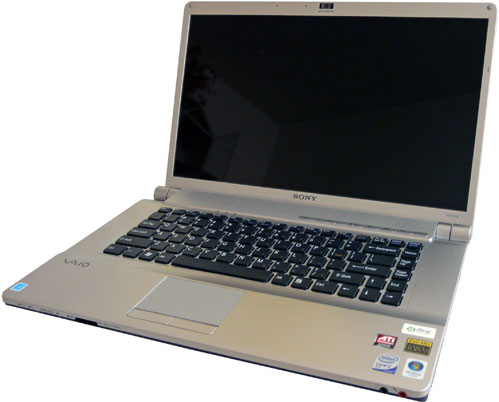
So, where does Sony's Vaio VGN-FW139E fit in? Well, nowhere to be honest. It's not expensive, but on the other hand it's stylish too, making it a nice companion for business people. It's not a gaming machine, either. God never meant for notebooks to be toys, anyway, but it still packs enough power to run undemanding games. It's not an overweight chunk of hardware like most 17 or 18-inch machines. The main thing that sets it apart from most 15.4 or 17-inch notebooks is its screen size and awkward resolution, packed in a compact chassis.
Sony opted for a 16.4-inch screen in a cinematic 16:9 aspect ratio. Its resolution is 1600x900, not something you see every day. Basically it's supposed to provide you with the benefits of a 17-inch screen in notebook with the footprint of a 15.4-inch unit. It lives up to expectations, and in some respects even exceeds them, offering a higher resolution than most cheap 17-inch notebooks (1600x900 vs. 1440x900), whilst keeping the size and weight down, almost on par with 15.4-inch models. The Vaio measures 38.4x26.2x3.7cm and weighs 2.9kg, just a tad more than an average 15.4-inch notebook.

Now, let's say a thing or two about its hardware and cost before moving on. Sony packed the FW139E with quite good components, such as Intel's Core 2 Duo P8400 clocked at 2.26GHz, the PM45 chipset and 3 gigs of Samsung's 800MHz DDR2. Its 250GB 5400rpm hard drive should be enough for most users. You also get n-draft WiFi, Firewire, Bluetooth, HDMI, a 1.3MP camera and a Memory Stick / SD card reader.
Luckily, Sony chose not to use Intel's IGP and opted for ATI's HD 3470 with 256MB of DDR3 instead. We have to admit this isn't a very powerful GPU, and we'd like to see something even better, mainly due to the high native screen resolution, but it's still a much better choice than an IGP. Although you can't expect to it to run Crysis, it will still cope well with many popular games, and let's not forget about HD video decoding and DirectX 10.1 support, either. All in all we think it's a good choice. It doesn't drive the price sky high and it doesn't consume much power.
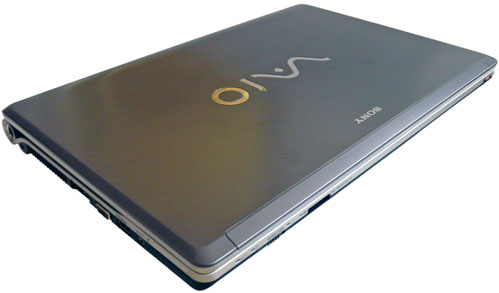
There you have it, we've got some rather nice hardware inside a stylish notebook notebook with a Sony sticker on it. You'd expect the price to be rather high, but at under $1,100, the Vaio starts to look like a pretty nice deal. You can get similarly equipped 15.4-inch notebooks for a bit less, but you'll end up with a 1280x800 screen, compared to Vaio's 1600x900.
The look of love (or hate)
Here's where it gets tricky. After publishing the preview, a couple of my colleagues told me they hated its looks. They said it was hideous, too Apple-esque for their taste, and they found some details, such as the oversized screen hinges with the power connector and power button, a bit too tacky.
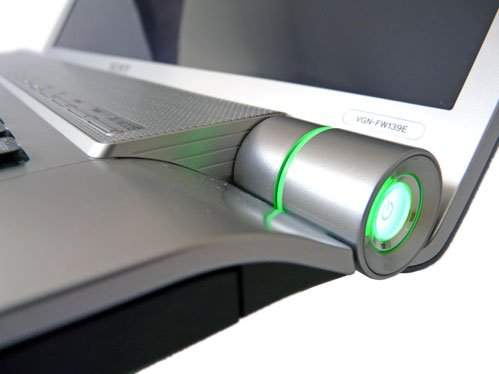
I beg to differ. True, the keyboard looks like it came straight off a MacBook, but who's to say only Apple should feature such a design? After all, we've seen manufacturers borrow dozens of design ideas in the past years. If it works, why not use it? It's not easy to come up with something new and original these days, as the designers seem to have tried just about anything. As for the hinges and power button, I think they look quite nice, although the illumination is a bit too much for my taste.

There are some things I didn't like, either. The lid is one of them. The Vaio logo is too big if you ask me, but this is true of all almost all Vaio notebooks. There's a white color option, as well, but it looks a lot better on pictures than in real life. Apart from the logo, I didn't like the finish, either. The color, a pale blueish shade of gray, is nice. However, it's just too smooth and the smudged fingerprints which stick to it like a chewing gum to asphalt would make life miserable for CSI people if somebody were to kill you and nick it.
It doesn't have a latch, so you'll get it smudged around the edge in no time. Some of your precious bodily fluids will easily end up on the camera lens in the process. Furthermore, the bezel doesn't feel quite right. It's flimsy, bends easily and at the bottom you could fit a coin in between the plastic and the screen. This is not something we've come to expect from Sony products.

Thanks to the 16:9 screen and unusual keyboard, the Vaio looks quite slim and elegant. The curved, sloping chassis is a nice touch, which offsets the sharp edged design, along with the round power button and hinges. The textured touchpad might be a bit too much, but it's not a big deal.

Overall, Sony did well in the design department. The Vaio FW-139 looks quite good, its design is simple, subtle and elegant and it looks a lot better than most similar notebooks on the market.
From Apple with love
Well, here it is, the keyboard straight out of Cupertino. Not much to say about it really, it's great to work with, the layout and quality are top notch, although we would have preferred a bigger Enter key.
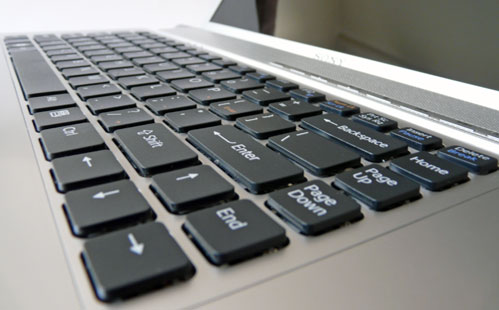
The only trouble with it is that it's quite tricky to clean, so if you're a clean freak, you can look forward to hours of fun.
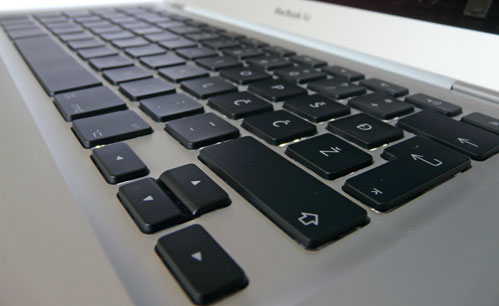
Here you can see the MacBook Air keyboard. Sony's keyboard isn't backlit like Apple's, but as you can see the basic idea is the same. We like the Apple layout better.
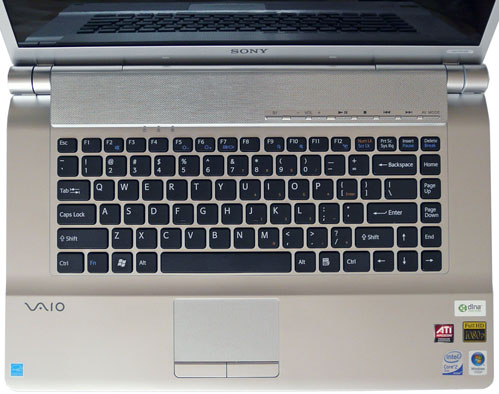
The touchpad is very nice. Responsive, spacious, and the keys feel great. The texture is just about the only thing to nag about, but it's no big deal.

Overall both the keyboard and touchpad leave a good impression. They feel robust, and everything is in the right place. You'll have no trouble getting used to the Vaio and the typing position is quite pleasant.
Ergonomics, everyday use, build quality
At some point Sony's engineers must have sat down and said: "We've done a good job up till now, we can afford to mess a few things up, can't we?" As I said, the keyboard and touchpad are great, but there's a couple of annoying issues when it comes to everyday use. A 16.4-inch machine will spend most of its time sitting on a desk and obviously, in such a scenario, you'd like to use a mouse, connect some devices or external speakers. Well, good luck with that, as it will be anything but pleasant.
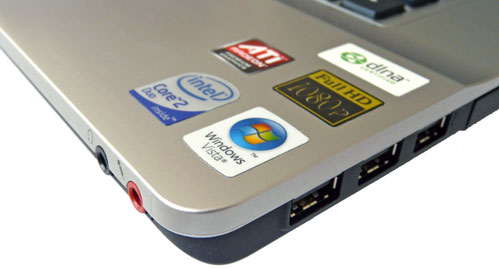
As you can see, all three USBs are placed on the right hand side. What's worse, they're at the edge of the chassis, so connecting a mouse, USB drive or some sort of dongle will take up a lot of desk space, as you'll need much more room for your mouse. If you're left handed, this isn't much of a problem, but the fact that all 3 USBs are on the right side is.
Secondly, the audio connectors are placed, well, awfully. Once you connect the speakers you'll have to drag the cable around the right side, around the USBs, or you can go left, in which case you'll end up typing with a couple of cables dangling under your arms.
If this were an ultra-portable machine, or a netbook we wouldn't moan about this. However, on a big, unwieldy machine which is meant to be used as a desktop, it makes no sense whatsoever.
The memory card reader and wireless on/off button are also placed at the front, on the left edge. This isn't an issue, as you won't use them that often and these aren't connectors with cables sticking out of them.

On the right hand side you'll find the optical drive, and those three unfortunately placed USBs. The power button is well hidden, and although it glows in a pleasant shade of green, like a veteran Soviet submariner, the light is a bit too strong and distracting when working in the dark. On standby, it's orange.

Most connectors are placed on the left side. You can see the Firewire, LAN, HDMI and power connectors, as well as a heatpipe with a bunch of fins. The cooling system is effective and relatively quiet, almost silent when not under load. Even after running several benchmarks and placing it on a soft, fluffy surface to cut the airflow, it managed to do its job. When it heats up, the heat is distributed evenly along the chassis. The whole thing heats up to body temperature, or slightly higher, but no hot spots appear, so it's still pleasant to use, especially on a chilly November day in Sarajevo.

The battery latch is quite good, once you secure the battery it can't budge. The 4400mAh unit surprised us by managing to power it for 2:18 hours in our Apocalypse Now Redux DVD test. You can squeeze out even more in regular use, and considering the screen size and quite powerful components, this is a good score. Although you still can't see Brando die, the Vaio is great for watching movies. The display quality is excellent, and the 16:9 aspect ratio helps. If it's still not enough, you can use HDMI and connect it to something bigger.
Benchmarks and Conclusion
Cinebench
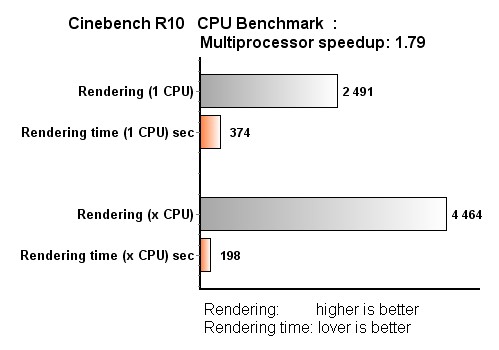

The Cinebench single CPU score is 2491, and the multi CPU score is 4464. Multiprocessor speed-up is 1.79 and Open GL performance is 2912. It rendered the test frame in dual-core mode in 3:18 minutes. Not bad at all.
3Dmark 06
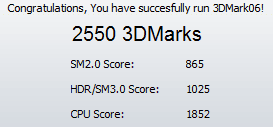
ATI's HD 3470 with 256MB of DDR3 is no powerhouse, but it's still vastly superior to any IGP on the market. It scores 2550 marks and the CPU score is 1852. Nice numbers, but the high native resolution will still prevent you from enjoying many games in their full glory. Taking down the level of detail will help. Still, the bottom line is you can play games on it. On an IGP, you just can't, it's as simple as that.
SiSoft Sandra
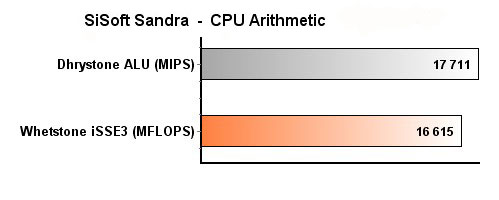
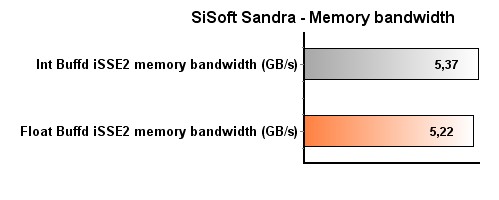
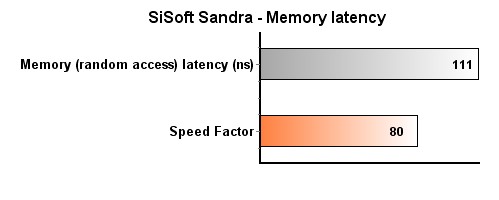
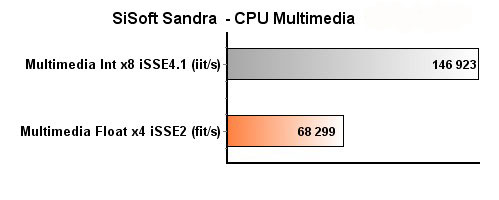
Sandra thinks highly of the P8400, and the scores are quite good. A high CPU clock, lots of cache, coupled with fast memory and a good chipset prove to be a good combination, matching mid-range desktops easily.
Conclusion
The Vaio performs well across the board. It's a well balanced machine, suitable for many uses, affordable and good looking. We do have some complaints, but nothing big.
So should you get one? Well, it depends. In case you're looking at $1,000 15.4-inch machines, the Vaio will offer you an extra inch of screen real estate and a higher resolution in a very compact package. Let's face it, if you're planning to carry your notebook around all day long, you'll get a 12 or 13-inch model to begin with. If not, the 16.4-inch Vaio is just marginally larger and heavier than a 15.4-inch notebook and it's a very tempting alternative.
If amateur video is your game, or if you just watch a lot of movies on your notebook, it will be great. It boasts Firewire, HDMI, a powerful CPU and graphics with HD decoding. The 16:9 screen will come in handy in audio/video editing software, and you can even play around with some post production effects thanks to the fast CPU and memory. For casual gaming, or graphically undemanding genres, the Vaio will suffice. In case you're a hardcore gamer, get a desktop.
We like its design. The build quality is good, apart from the aforementioned bezel issue, most materials feel quite nice. You either love or hate the Apple-esque keyboard. Personally, I liked it, but a few people on our team didn't. It turns heads, not as much as a MacBook Air, but it still leaves quite a good impression, although a few people thought it was an Apple. Anyway, if you're too smug for Sony, you can always get an Apple.
In terms of value, the Vaio VGN-FW139E is a great deal. In fact, you can even get it for under $1,000 if you're lucky, although most retailers are listing it at $1,100+. It's worth it, without a doubt. In fact, Bestbuy is currently offering it at $899, after a $250 rebate, and you have to admit this is a bargain. This is not the first time we've seen it sell for under a grand, Newegg had a similar deal a month or two ago.
Such a reasonable price is not something you'd expect from Sony, quite the contrary. Therefore, it gets our Top Value Award, and this is where it beats any Apple out there, with or without the borrowed keyboard design.

